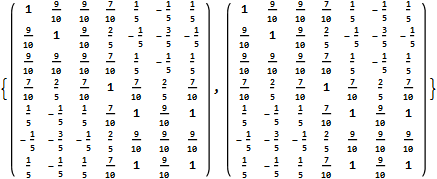I have the following 7-by-7 matrix of cosine similarity measures:
Cosine-Matrix={{1, .91, 1, .78, .22, -.18, .22}, {.91, 1, .91, .46, -.18, -.57, -.18}, {1, .91, 1, .78, .22, -.18, .22}, {.78, .46, .78, 1, .78, .46, .78 }, {0.22, .18, .22, .78, 1, .91, 1}, {-.18, -.57, -.18, .46, .91, 1, .91}, {.22, -.18, .22, .78, 1, 0.91, 1}};
Through a reordering process this matrix can be transformed to the following:
Reordered-Cosine-Matrix={{1, 1, .91, .78, .22, .22, -.18}, {1, 1, .91, .78, .22, .22, -.18}, {.91, .91, 1, .46, -.18, -.18, -.57}, {.78, .78, .46, 1, .78, .78, .46}, {.22, .22, -.18, .78, 1, 1, .91}, {.22, .22, -.18, .78, 1, 1, .91}, {-.18, -.18, -.57, .46, .91, .91, 1}}
This new matrix has the property that it is symmetric with diagonal entries equal to one and whose entries to the right of each one are decreasing from left to right.
A MATLAB function, which performs the reordering and which was provided by the authors of the article where I found the above matrices, is below. I'm having a hard time translating it to Mathematica.
In the code below "a" is the input cosine-similarity matrix; "z" is the reordered matrix)
function z = reorderM(a)
[s,dummy] = size(a); %number of rows in a = number of nodes
A = a; % create new variable A = a to reorder according to index I produced
for i = 1:s
b = a(:, 1:2) % Extract first two columns of a, index column and ist node column
[dummy1, index] = sortrows(b, -2) % Sort 1st node in descending order
c = a(index, :) % re-sorted rows according to index
c = [c(:, 1) c(:, index+1)] % re-sorted columns according to index r
I(i:s, 1) = c(:, 1) % record index in terms of node ids
a = c % put a = new reordered c
a(1, :)=[]; % remove first row (sorted node)
a(:, 2)=[]; % remove first (second) column (sorted node)
c = 0; b = 0; index=0;
end
% Use index I to reorder the rows and columns of A
z = A(I, :)
z = [z(:, 1) z(:, I+1)]
z = [0 z(:, 1)'; z]



matis your matrix, none of the possible reorderings generates a symmetrical matrix. (the following all return false: reorder rows:SymmetricMatrixQ@mat[[{1, 3, 2, 4, 5, 7, 6}]], columns:SymmetricMatrixQ@mat[[All, {1, 3, 2, 4, 5, 7, 6}]], and both:SymmetricMatrixQ@mat[[{1, 3, 2, 4, 5, 7, 6}, {1, 3, 2, 4, 5, 7, 6}]]). $\endgroup$